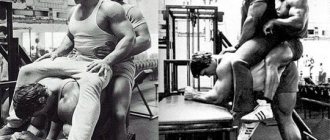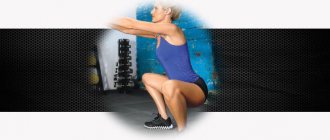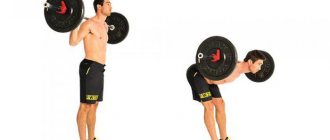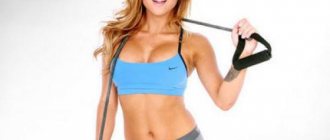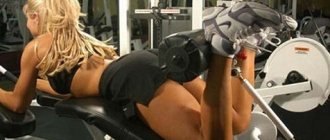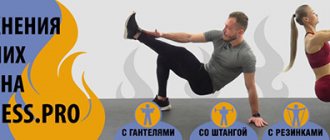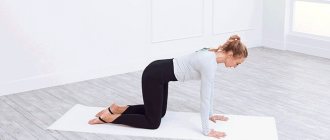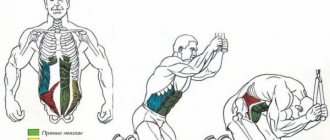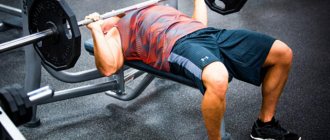At many extreme strength competitions you can see a special exercise called the Farmer's Walk. The public is enthusiastic about a tough man who can carry a couple of heavy objects. A full-body exercise like this is an excellent basic preparation for bodybuilding.
- What does the exercise develop?
- What muscles work?
- Benefits and contraindications
- Exercise technique
- With weights
- With dumbbells
What does the exercise develop?
In the gym, only some training visitors include the farmer's gait exercise in their mandatory program, while others do so very rarely. Completely in vain. The stimulating complex is quite effective for muscle mass. Helps increase the body's endurance.
The main load during the exercise falls on the upper back. In addition to the work of the trapezius, other muscle sections also develop:
- the entire shoulder area;
- biceps thigh area;
- gluteal muscle tissue;
- abdominal Press;
- shins;
- quadriceps;
- arm muscles
The “Farmer's Walk” exercise can be compared with some types of basic complexes in terms of the degree of impact on muscle tissue. For example, this is a deadlift or squats with a large load (barbell).
The only difference is that it is performed in motion, so a person expends more energy during this strength exercise. It can be included in a complex for weight loss, and not just for building muscle mass.
Let's dive a little into history and figure out what the Farmer's Walk is. In essence, this is ordinary walking, but with weighted objects that need to be held by any means.
The exercise was invented by Dan John. A US resident was involved in discus throwing, and later became a coach. In 2001 he received a severe injury, so he could not fully exercise in the gym. He came up with a kind of farmer's gait, which required him to carry heavy loads. Gradually he was able to recover and improve his primary strength indicators.
The main thing is that it is comfortable to hold in your hands and carry over a long distance. At first glance, it may seem that the exercise itself is boring. To diversify it, they use changes in speed and distance, turning the strength complex into an extreme and original exercise.
In addition, performing the Farmer's Walk from the gym can be transferred to the forest, to the country house. This will only improve the quality of the universal exercise.
How to perform the Farmer's Walk exercise correctly?
This is a fairly simple exercise from a technical point of view, but it has some features.
To perform the exercise, a barbell equipped with handles is most often used. At the same time, you can use weights or dumbbells. Stand between the implements and, tensing your abdominal muscles while keeping your back straight, take them in your hands. By pushing your body up with your heels, you are in the starting position. Take short but quick steps and move in a straight line, using proper breathing.
The distance for one walk is most often from 25 to 50 meters. Having reached the finish line of this distance, it is necessary to lower the sports equipment to the ground. After that, turn around and do everything again in the opposite direction. In one lesson you should perform from 5 to 10 such walks, without pausing between them.
What muscles work?
When performing the exercise, the following muscle areas receive the load first:
- abdominal Press;
- lumbar region;
- shoulder area;
- buttocks.
When walking, the quadriceps muscles are directly involved. Secondarily, the trapezius, deltoids, and muscles of the hand and forearms are involved.
The advantage of such a load is the difference between moving with a barbell. The exercise can be performed under any condition. As weights, you can use barbell plates, weighted bags, dumbbells or cylinders filled with water.
Benefits and contraindications
The main benefit of performing strength exercises is the active production of testosterone. This hormone is responsible for the growth of muscle mass throughout the body. Thanks to the willpower of a person, an increase in endurance is developed, and the fat layer is also reduced.
During the exercise, a person carries heavy equipment over a certain distance. For this reason, athletes and bodybuilders who take part in various extreme strength competitions most often include it in their program.
The main benefits of the exercise that strength athletes and crossfitters will appreciate:
- The grip is strengthened. Exercise has a positive effect on the muscle tissue of the forearms and the skeletal system. This quality is useful when performing other types of strength exercises, for example, deadlifts.
- The central part of the body is perfectly worked out. When an athlete moves, the entire core musculature takes part in the movements, which helps him transfer weights to the required distance.
- Building muscle mass. When performing “farmer’s” walking for a long time, the muscle fibers undergo hypertrophy. Due to increased testosterone levels, muscle, size and mass are built.
- The body balances better. When walking with weights, the work also includes small muscles, which are responsible for coordinating movement and stabilizing the condition. Therefore, the exercise has a positive effect on the athlete’s balance.
- The body's endurance increases. Not only the muscle tissue is strengthened, but the ligaments of the legs. Arms, back.
Now let's move on to the disadvantages of strength training. The farmer's walk is supposed to help both hold and move heavy objects. The conclusion follows: the complex has a negative effect on the knee joints and lumbar spine. If there are pathologies in the musculoskeletal system, it is not recommended to perform this strength exercise.
Farm walking is contraindicated for the following ailments:
- shoulder sprain;
- the functioning of the vestibular apparatus is disrupted;
- serious cardiovascular diseases.
“Farmer's walks are the hardest exercise for advanced athletes, and if your grip is strong enough to hold a heavy weight, farmer's walks will create a powerful load on the entire body. They really work your entire body from head to toe - as long as you use heavy weights." Brooks Kubik.
Weighting.
For a farmer's walk, you can use almost any weights, the main thing is that they are of the same weight and brutal.
It is advisable that the weights be flat, like suitcases, so that they cling less to your legs and do not interfere with running/walking. It is also desirable that the handle you hold is higher than the center of mass, this will improve handling when turning. The thicker the handle of the weight, the more the grip is loaded, but you should not look for a handle that is too thin, because... These will cut your hands. For my taste, it is most convenient to use a handle with a thickness of 25-28mm, ideally with a notch, but I don’t mind without it.
If you use a dumbbell, you need the handle to be long enough, otherwise when walking, the protruding plates will limit the width of the step, and limit it quite painfully (if anyone doesn’t understand, accelerating with your knee into a pancake is woooooo painful). My distance between the dumbbell plates is a little more than half a meter, while I have enough space for the widest possible step.
When using “suitcases” or oxygen cylinders, you need to be careful how you throw them on the ground at the end of the set, so as not to hit your leg with an iron pig, feeling your own lack of fuckability from the distance covered.
Start.
To start, it is advisable to choose a level place, but as practice shows, it may not be very good. I use magnesium, and I recommend it to everyone, it is not a super grip replacement product, but in the heat when your hands sweat, in the rain and snow it makes the grip easier.
You need to stand so that your shins are in the middle of the handles or so, grab the handle with your palm so that it (the handle) is not above the calluses, but just behind them further from the fingers, and clench your fist into a normal grip. Grabbing the handles slightly forward of center can give extra acceleration and control, but only works with relatively light weights. A similar situation is if you grab a little back, then you will walk more levelly, but again only with a relatively light weight. When carrying in this way, the load is not evenly placed on the grip, and some fingers have more than others, the weight will quickly escape from the hands under the influence of gravity.
If you are running at speed, then before the go-ahead you need to slightly tighten all the muscles, this will give a more powerful impulse, lean forward a little (become in a position more for deadlifting than for a squat, but everything greatly depends on the shape and height of the weights used), and on the go-ahead break weight and start catching up with it with your feet, this will give additional acceleration. But when you work with serious weight, there is a chance that you will not be able to close your back, and then there will be no stability.
If you are running a farmer's distance, it is better to get comfortable and fully prepare for the run.
In this case, it is enough to simply do a regular rise from a squat, this will allow you to fix the back muscles in the desired position and start with an already cast block of tense muscles. Walk.
The walk is very simple, when you have lifted the heavy dumbbells, you need to forget about everything, tense your entire back, locking your shoulder blades and sticking out your chest, squeeze your fingers around the handles of the dumbbells until they turn white and go go go go until your legs move, hold your arms and back, or until you will go the required distance.
During a walk, it is very important to maintain the pace, this not only gives speed of passage, but also allows you to reduce the time under load, accordingly, walk a greater distance, until the moment when either your fingers unclench and are unable to hold back the weight rushing down, or you can no longer rearrange the clogged blood, legs that are heavy and not flexible like logs, or simply the weight will begin to fold you in half and you will drop it so as not to get hurt. In addition, when I keep a good pace, my nervous system is more charged, it’s easier for me to hold my back and walk with my legs, and my movements are more coordinated.
When you walk with a lot of weight, it is advisable to take not wide steps, but many small ones, and as quickly as possible, then the joints of your legs are not so heavily loaded, because when you transfer weight from one leg to the other, almost all the weight you carry falls on one leg, and you directly feel the pressure in every joint. This remark has almost no effect on small weights; for example, I even managed to run with a small weight, in the literal sense of the word.
After reaching the place, the main thing is not to crush your legs with dumbbells in joy, and not to fly up from the feeling of lightness that forms immediately after placing two almost 100 kilogram dumbbells.
And then you need to eat a lot, sleep a lot, and get sick of the feeling of weakness and lethargy of the whole body, because... a really HEAVY farmer, it beats up the whole body.
This is how the cube described it:
“In total, each of us carried these pieces of iron five times. I managed to reach the border of the site four more times. Bruce walked a little less. Tad covered about 15 meters in each of his four remaining attempts. When it was over, we were DEAD. We were “nothing.” — What muscles does this exercise work? - asked Tad. - All! - I answered. “It turns on the GROW OR DIE mechanism,” Bruce explained. - You will either become bigger and stronger, or you will die - there is no third option. And these suitcases don’t care what you choose.” Brooks Kubik.
addition from 07/16/2009
Once again about weights...
Below is a photo of my farm dumbbells. The main disadvantage of these dumbbells is that the handles by which I hold them are not high from the floor, but somewhere at the level of the middle of the shin, i.e. you will have to do deadlifts with them first, as you can see in my corresponding video on the main page. It is advisable to make the handles of the dumbbells much higher than mine - at knee level, so that you need to do a lockout in the deadlift, and not a full deadlift.
My dumbbells are easy to make without any special equipment. This is a triceps bomber bar that can be bought at any sports store. There are 2 metal bushings put on it and they are fixed on top with locks that are tightened with a pin on the thread. The bushings are made to give the leg enough swing even with a wide stride.
addition from 11/01/2010
The best option for weights:
I've been thinking about upgrading my farmer's dumbbells for a long time. The old triceps bomber bar did not allow it to reveal its potential (and on top of that, it also wrinkled), due to the fact that first it was necessary to stretch it to its full amplitude. And I’ll tell you this in a fun way, first do a failure row of dumbbells (this is heavier than barbells with the same weight, if you don’t train this movement specifically!), and then also walk 15-20 meters with this weight, when in your hands it’s 200 kg a really tough task.
That's why we did what you can see in the last picture. The advantage of this dumbbell is that its handles are at a height of 43 cm from the ground, this is somewhere under the knee, it turns out to be a lockout and this helps to pull out a lot of weight. The dumbbell is made of - thick reinforcement, edge diameter 29mm (for a pancake with a seat diameter of 30mm), 1 meter long, - iron strips 4 cm wide, and 3mm thick (their length varies depending on the radius of the pancake to select the desired height, I have them 25 cm long, and - a smooth pipe, behind which this whole structure rises, a pipe 30 cm long, and 34 mm in diameter (here I made a mistake, it should have been thinner, but thick-walled).
Now briefly about the how and what. As you can see in the photograph, the plates are located on both sides of the pipe and fittings and are welded to the edges of the pipe and at the same width to the fittings. With the thickness and length of the iron strips I have, the dumbbell remains rigid and does not twist or play when I turn around with it. If you make a farmer with longer plates, you will probably have to add braces so that the dumbbell does not twist when turning and is more rigid. At a distance of 30 cm from the center of the reinforcement, metal plaques are welded, these are limiters for the pancakes, the total length of the reinforcement in which you can walk is the same 60 cm, but in this case the pancakes are lower, so it probably makes sense to give more space for the step. Although when you walk with a really heavy weight, the steps are not long.
The pancakes are secured with an ordinary spring lock, as on our other bars.
Exercise technique
To perform the exercise, you can use any weighted equipment. For example, these could be weights, dumbbells, a trap bar, or unusual options (a live pig).
Before you start the exercise, read the article - Stretching before exercise
With weights
For greater load when performing farmer's walking, it is recommended to use weights. In this case, the upper part of the shoulder girdle will actively work. Let's consider an option for performing the exercise.
- Place your feet shoulder-width apart. Keep your back straight, with a slight arch in your lower back.
- If you have a strong grip, it is recommended to hold the weights by the handles. This will help strengthen the muscles of the forearm.
- Determine the distance and start moving.
If you don’t have enough strength when carrying weights, you can bend your elbows and hold the weights with your wrists slightly tucked under the arms. In this case, the weights will rest on the elbow bends.
A more difficult modification of the farmer's walk involves holding weights on your shoulders. While walking, the weights are held with your fingers, while the elbow joints are bent and looking to the sides.
With dumbbells
The algorithm for working with dumbbells is as follows:
- Take heavy dumbbells from the floor. Bend the lumbar region slightly and fix the position.
- Keep your back in the desired position, bend your knees, and take dumbbells. To go a long distance with dumbbells, it is recommended to use bands that help relieve stress on the muscles.
- Take a step forward, placing your heel on an imaginary line. As a result, the stride becomes shorter.
Short steps reduce the range of motion in the vertebrae and pelvis. These are the most vulnerable places in the human body when enduring compression loads. Throughout the entire “farmer’s” gait, you should keep your body level so that the trapezius muscles seem to be spread out over the upper part of the shoulder area.
For experienced athletes, exercise is an integral part of the training process. It helps adapt muscle tissue to perform monotonous complexes with improved results.
Complex “Squats with a kettlebell + exercise with ropes”
Andrey Kurak and Anastasia Minkevich.
Before appearing in the “Critical Mass” project, they weighed 93 and 75 kg, respectively. Andrey has since lost 13.4 kg, Nastya - minus 8.4 kg. Purpose: squats with a kettlebell develop the muscles of the lower body, the biceps and shoulders are subject to static load. The ropes involve almost all muscles, and most of all the shoulder girdle, core stabilizers and lower back. Cable work can be considered a form of cardio training.
Technique: starting position - feet slightly wider than shoulders, toes turned outward. The kettlebell should be held with bent arms at chest level and close to the body. Elbows point down. As you exhale, perform a squat, keeping your back straight. Depending on your flexibility and physical shape, lower your pelvis as low as possible. Make sure your knees don't roll inward as you lift.
The exercise with ropes can be performed with parallel and alternating movement of the arms “down and up” into a half-squat position, legs slightly wider than shoulders and turned outward. We move the ropes with powerful rhythmic jerks at a given breathing rate, thereby creating a “wave”.
Andrey Kurak
Number of repetitions: 15 goblet squats (kettlebell squats - Ed.) and 30 rope strikes in one round. For physically strong guys, a complex with four rounds and a minute of rest between them will be suitable.
Can this exercise be done at home? If you have the necessary equipment or its substitutes, you can train anywhere.
Nikita Yundov, crossfit trainer
We express our gratitude to Nikita Yundov, who conducted a CrossFit lesson for four couples - participants of the “Critical Mass” project: Natalia and Alexander Shisha, Maria and Denis Leschunov, Elena Rydevskaya and Pavel Dureiko, Anastasia Minkevich and Andrey Kurak. Starting in June, when the guys began to lose weight according to Nikita Danko’s program, they lost a total of 134.4 kg.
